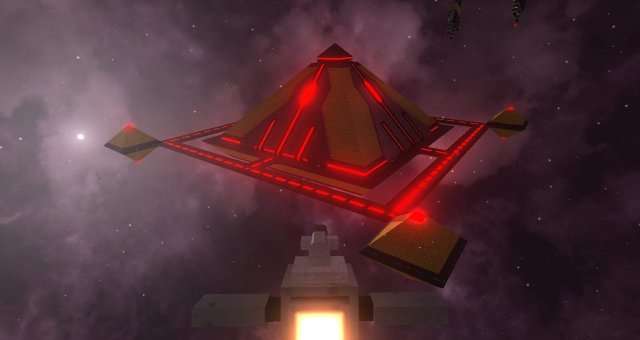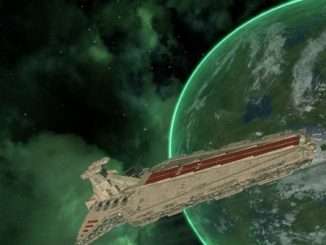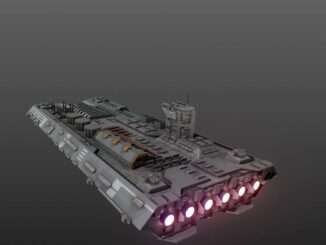
Trading is, in my opinion, the most reliable way to earn credits in Avorion in any stage of the game, and it’s also a great way to increase faction reputation.
Find out how you can earn enough credits to upgrade your ship to an 11-slot monstrosity, buy or craft the best turrets and upgrades, or to build your own stations (note, guide to station-building not included as of yet).
How to Trading and Earning Credits
The Very Beginning: Obtaining Capital
When it comes to trading, both in the game and in real life, there is one inescapable rule: you need money (capital) to make money.
Unfortunately, you don’t start with very much of it. You only have 10,000 credits, and a significant portion of it would probably be spent building your first ship.
Fortunately however, there are other ways in Avorion to earn enough credits to begin trading.
Selling Asteroids
Probably the easiest method to gain the capital, as even one asteroid can sell for over 50,000 credits if you have a friendly faction nearby. Just look around for oreless asteroids that are much larger than the others; they typically have a more complex, “rough” shape to them. If you move within 0.2 km of them, the “interact” prompt will appear (if it doesn’t, the asteroid is unfortunately not quite large enough).
Press the indicated key (F by default), and there will be an option to “Claim” it. Interact with the asteroid again, and you can then sell it to a nearby faction. (There is also “build mine” but you probably can’t afford that yet.) The amount of credits they offer is based on your current diplomatic relation to them.
You may be lucky enough to find one even in your starting sector; however if you’re not, you may have to explore several other sectors. Just find a warp gate and go through it (try to stick to friendly sectors when starting out)
Soon enough you will be hailed by an NPC “adventurer”. Just ask them what they are doing, then wish them luck, and you’ll receive a free “radar upgrade” module. Select Ships -> Systems to equip it, then go to the map (M by default) and look for the yellow dots (hidden mass sectors). (Note: early ships tend to not have much spare energy, so it’s OK to simply unequip the upgrade once you know where the yellow dots are. If your memory is poor (like mine is sometimes) you can right-click on the yellow dots and “tag” them so that you can find them after unequipping the radar upgrade.)
You can continue sticking to gate-network sectors, or you can try visiting a green or yellow dot you find away from the gate-network; however, it is not recommended to blindly jump to an off-network sector, especially a yellow-dot hidden mass sector, in your starting ship. They often contain that all-important claimable asteroid, but they also sometimes contain pirates, usually about a dozen of them or more, that could completely obliterate a starting ship while you slowly wait for your hyperspace energy to recharge. Instead, switch to your mining drone (by pressing T, or by shift-clicking the “exit into drone” icon at the top right) and jump there with it first – yes, even your mining drones have FTL capability, and they often have much shorter hyperspace recharge times than your main ship.
If you see pirates in a hidden mass sector, quickly go back to your map, right-click on the sector you left your ship behind in, and click “Switch to Sector”. It’s OK if your mining drone is destroyed, but don’t dawdle too long or you may “respawn” in your regular ship, but within the pirate sector. If however the way is clear, you may spend a little bit of time looking around to see if there is anything of interest. Even if the sector doesn’t have a claimable asteroid, you may find stashes that you’d want to open, or titanium asteroids to mine that’ll help to upgrade your ship.
Other ways to earn capital
If you’re really unlucky with claimable asteroids, you may be able to earn the starting capital the following ways:
“Combat” and salvage
Your starting ship is probably not quite fit for “real” combat in all but the easiest difficulties. However, if pirates attack the sector you’re in, and it’s a populated sector, you’d likely have a number of friendly combat ships from the controlling faction that will go and fight them. You can thus try to “help” them by shooting the pirates with your starter chainguns. (Note that their range is only about 3.5 km, so you have to be pretty close. You know you’ve hit them when numbers begin to fly.) Be careful; if they begin to shoot back, get away and try to refocus their attention to one of the NPC ships. Even this token effort will net you a reward (~15,000) when the pirates are defeated, and sometimes a useful turret or upgrade. Unfortunately, alien attacks (as of the time of writing) don’t produce any reward other than faction reputation.
However, regardless whether they are pirates, aliens, or even another faction, combat leaves behind defeated ships and wreckage. Often there are turrets and upgrades that fly out of them when they are defeated that you can just pick up; however you may earn even more turrets and upgrades by searching the wreckage (i.e. blowing it up). Don’t bother getting every last piece, just break up the larger bits.
If you happen to have a salvage turret, you can equip it and get some minerals during salvage, but generally the turrets/upgrades are your goal, so your regular weapons will do fine.
If you find useful upgrades and turrets, you can equip them. Sell unneeded ones to a nearby equipment dock. (On the map screen, there is a search bar on the top left; your starting sector would also have an equipment dock)
Be especially on the look out for “transporter upgrades”. It is recommended you sell these in the early game, because you can’t actually use them till late game (when you obtain Xanion), and by then you probably would have looted a higher-quality version. Even a common one can sell for a whopping 625,000 at an equipment dock!
Missions
Another possible way to earn capital. Unfortunately right now there isn’t much variety to the missions, and the only one I can recommend as a capital-earning method is the “Explore Sector” mission from a Military Outpost. If you get one, and if the target isn’t too far from the gate network, and if scouting it with your mining drone doesn’t reveal a bunch of pirates ready to destroy you, go for it! You may also find very useful things in that sector, like claimable asteroids, secret stashes, and even sometimes abandoned ships you can restore (they are probably not spaceworthy though, so just switch to them, go to build mode, and delete all the blocks to reclaim the resources)
As for the other mission types, “Resource Shortage” missions are the most common and can be quite lucrative, but I consider it a form of trading, since you both need the capital to obtain the goods, and the cargo space to store it; as such, I will cover those as one of the trading strategies. “Delivery” missions also require cargo space and capital, and I personally don’t recommend them, as the destination isn’t revealed to you until after you accept them, and 20 minutes can be quite a rush depending on where it is (it may be behind a hyperspace rift, or in enemy territory, or require several jumps away from the gate network). If you fail, you get stuck with the goods and have to find a buyer for them. “Wipe out Pirates” missions are best left until you have a good enough ship or fleet to take on two dozen-ish pirates.
There is no penalty to failing or abandoning a mission, except for the possibility of getting stuck with a good that you can’t find a buyer for in the case of Resource Shortage or Delivery.
Mining
I’d treat this as a last resort, because you’ll usually want to save minerals for upgrading your ship. But, if you have absolutely no luck with either of the other methods, this is a slow-and-reliable way to earn your starting capital. Simply go to a resource depot (there is one in your starting sector too) and sell off the minerals you collected. It is recommended you only sell iron to begin with.
Recommended Requirements for Trading
- A ship with at least 100 cargo space; more is better, especially if you can get at least 200. Speed is also very useful, as is brake thrust; you’d want to be able to travel between stations and gates quickly, and have enough brake thrust to avoid overshooting the stations every time you try to dock with them.
- A “trading system” upgrade of at least common quality. If you didn’t loot one, you may be able to buy one at an equipment dock; the common one should only cost 8,000 credits. If you can’t find it there, note that in single player, you can refresh an equipment dock’s inventory simply by logging out and logging back into the galaxy; it shouldn’t take too long to find the common one, cause it’s, well, common. It’s also possible to trade without one, but it can be a bit more difficult, especially if you’re not familiar with what kinds of goods stations normally buy or sell.
- At least 25,000 credits of capital after the other expenses, so don’t spend too much on a fancy ship or trading system if you can only barely afford it!
Final Tips before We Get to Trading
- If you find a civilian ship (icons should be square), ask them where their home sector is. (You can do this even with your starting faction). Home sectors are often useful stops in trading routes as they contain a lot of stations, as well as stations personally useful to you like equipment docks and resource depots.
- Avoid buying from Turret Factories for any trading purpose. They sell goods for way above base value and you’d typically make a loss when trying to sell them. They are only provided for convenience for players wanting to craft turrets (and too impatient or unlucky to find another source of those goods), not trading.
Trading Strategy 1: Resource Shortage Spam
Advantages of this strategy:
- Only needs the minimum requirements listed above.
- Lucrative, as the mission rewards are well above the margins you’d get in normal trading.
- Low-risk (read on to see how to minimize risks).
Disadvantages:
- Somewhat luck-dependent (but you’re very likely to find opportunities *eventually*).
- Doesn’t scale well with your resources later in the game, when you have much more capital and cargo space (cause the amount of goods requested are always constant).
- Can be stressful rushing back to the requesting station, but this can be managed by only buying the goods if you’re confident you have enough time to make it back.
Other notes:
Though it is possible to make other kinds of trades with less than 100 cargo space, you really want at least 100 for this strategy, because goods in a resource shortage mission must be delivered all at once, and the number of goods requested is always either 150 or as many as can fit in 100 cargo space, whichever is smaller. Thus, it’s possible to get a mission that requires less than 100 cargo space, but 100 is the most common requirement.
Now for the strategy. Simply do the following:
- Travel to any populated sector belonging to a faction that’s at least “mistrustful” or better. The more stations there, the better. You can even perform this strategy while exploring new territory.
- Middle-click on all stations with exclamation points with them, “interact”, and accept all resource shortage missions.
- Then use the trading system menu (should be a pile of coins on the top right), compare it with your missions, and see if anyone is selling a good that was requested. Sometimes you may be lucky enough to find a seller right in the same sector.
If you don’t find anyone selling a required good, simply move on to the next sector, and repeat.
If however you do find someone selling a required good… don’t rush to buy it yet. Check to make sure:
- The station is not a Turret Factory.
- Check the Avorion Trading Goods Table (link above) to make sure it’s not a “dangerous” good. If it is, you may have to consider buying a license for it at a Trading Post (check to make sure it belongs to the controlling faction) before shipping the good to avoid getting fined. Note that they cost 100,000 credits, and only apply to one faction’s territories, and are only available if you have enough reputation in that faction.
- The station is stocking enough of the required good.
- You can afford to buy the required goods.
- You have enough time to return to the station requesting the good. If the time remaining is 15 minutes or over you’re probably safe (since, logically, it took you 15 minutes or less to travel to your current sector and discover the opportunity); if less, you may have to consider how many gates/jumps you have to go through to get back to the sector
Remember, the only real penalty of this mission comes if you spent all your money on a good that you failed to deliver in time and can’t get rid of! Fortunately however, this should be rare; usually the station requesting a good for a resource shortage mission is also able to buy the good normally. Occasionally however, they may not have the stock space required, or you may be forced to take a slight loss.
I find that with this strategy you don’t really need to pay much attention to where you might be able to get the goods requested; as long as you accept enough missions you’ll find some of them eventually, and the rest can simply be left to expire without penalty. However, sometimes you can easily spot opportunities; for example, they ask for aluminium, and there is an aluminium mine just one gate over.
Trading Strategy 2: Compare and Contrast
Advantages to this strategy:
- Reliable; if there is a good trade route you will eventually find it.
- Scales well with your resources later in the game.
- Lowest risk.
Disadvantages:
- Can be tedious; requires the most “bookwork” of the listed methods, but a better trading system upgrade can alleviate this.
- Not quite as quick as the resource shortage spam strategy early on, as you don’t sell your goods for quite as high a price.
In a populated sector, open the trading menu. Sort either by name (which helps you compare good-by-good with other sectors) or by price ratio (requires at least advanced trading module; may be harder to compare good-by-good but may save time focusing only on the goods with most potential). and take note of as many good prices as you can manage to (taking screenshots and pasting into an image viewer is one way to do it). Travel to another sector (or several other sectors) and do the same. You want to find a station that sells a good cheap, that another station will buy for more, i.e. “buy low, sell high”. Also check that:
- The good is not “dangerous” or “illegal”, or you have/can get the license for it.
- The destination station has enough stock space for you to sell the goods.
Rarer trading modules can help this strategy by cutting down on this bookkeeping significantly, essentially automatically finding opportunities for you. However, only prices are shown, not stock space.
Trading Strategy 3: Roving Merchant
Advantages:
- Scales well with your resources later in the game.
- Less “bookwork” than the previous two methods.
Disadvantages:
- You really want at least the uncommon “Improved Trading System” to be able to easily judge if a good is cheap/expensive compared to the base value. You can use the common one and compare it with the Avorion Trading Goods Table (link above (note that base price per unit is the first number in the brackets, not the number outside; that’s base price per volume)), but that could end up being more bookwork than the second method, negating one of this method’s chief advantages
- Moderate risk of getting stuck with a good that you can’t sell. Can be mitigated, but requires at least some familiarity with which goods are easy or hard to sell.
If you’ve ever played games like the Tradewinds series, you’d be familiar with this strategy. Basically, go to a sector, buy something that’s cheap compared to base price, then sell whenever you find a buyer offering a good price. Other than price ratio, you should also consider:
- “Bulkiness”, i.e. if a good has low value compared to the volume it takes up, it’s less desirable.
- Ease of finding a consumer station. If the Avorion Trading Goods Table (link above) lists only “Trading Post” as a consumer (which means you can only sell it if a trading post generates with that good in its sell list), or if it lists only one or two specialist factories e.g. “Targeting Systems Factory” and you don’t know for a fact that one is nearby, avoid that good.
- As per usual, only ship dangerous or illegal goods if you’re willing to take the risk or buy the license.





Be the first to comment